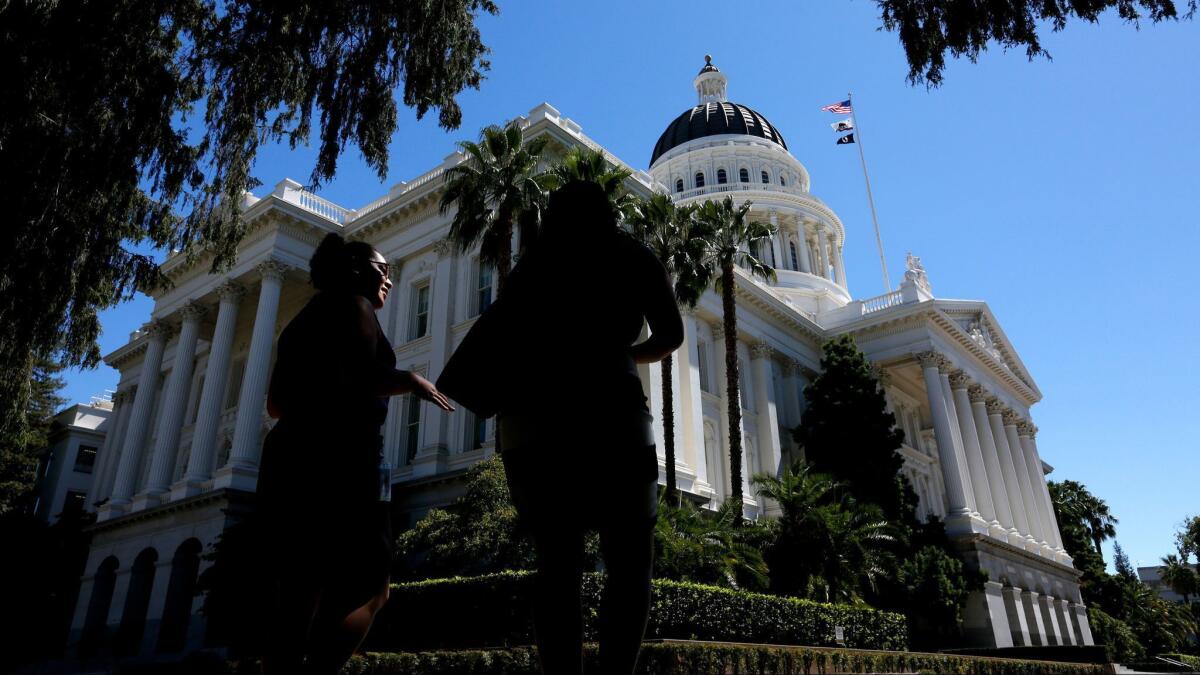California’s budget could soon be flush with $26 billion in unspent cash, analysts say

- Share via
SACRAMENTO — In a sign that California’s economy might remain at cruising altitude into the new year and beyond, analysts said Wednesday that the state budget could see a record $26 billion in cash reserves by the summer of 2021, with more than a quarter of that amount an unrestricted surplus that lawmakers could use at their discretion.
The report by the nonpartisan Legislative Analyst’s Office suggests that the second year of Gov. Gavin Newsom’s new administration could be very similar to the first, with debate not about how state government makes ends meet but rather how much more it should do to provide funds for schools, healthcare and public safety.
“The budget picture is strong,” Legislative Analyst Gabriel Petek said on Wednesday. “But that doesn’t mean there aren’t caveats to that.”
The report by Petek’s researchers estimates a $7-billion surplus in tax revenues by July 2021. Those dollars are considered to be one-time in nature, and the LAO report urges lawmakers to be cautious in how much they increase long-term government spending commitments when crafting a new budget next year.
“We think there’s about $1 billion of ongoing spending capacity in the state’s overall general fund,” he said.
The $7-billion surplus would be in addition to an expected $18.3 billion in “rainy day” reserves that must be set aside for an economic downturn and another $900 million that will be earmarked to assist social services programs in the event that recession pressures mount. The LAO report assumes the first signs of a recession appear in early 2021. Any acceleration or delay of that economic weakening could substantially change the size of the projected cash reserves.
Newsom, who is in the process of crafting a budget proposal that he must present to the Legislature by Jan. 10, used the report to contrast the fiscal record of California — led by overwhelming majorities of Democrats in Sacramento — with the gridlock in Washington and long-term shortfalls projected under budgets championed by President Trump.
“Our state is proving what big-hearted, progressive governance can look like — all without breaking the bank,” Newsom said in a written statement. “President Trump talks a lot about America’s economic growth under his presidency, but when you look behind the numbers, you see that it’s California’s growth that has provided the economic rocket fuel for the nation.”
Last week, state employment officials estimated that more than 15% of the nation’s job growth since 2010 has happened in California. The state’s unemployment rate in October fell to 3.9%, the lowest recorded under data analyses used since the 1970s.
Most of the $26 billion in cash reserves, including the projected $21 billion in reserves expected by next summer, must be set aside for use only in dire situations. California voters strengthened that mandate in 2014 by approving Proposition 2, a ballot measure championed by then-Gov. Jerry Brown and legislative leaders. Proposition 2 requires some of the money to be spent on existing debts owed by the state and the governor and legislators to declare a formal emergency before dipping into the cash reserves for spending on existing programs.
Newsom went even further after taking office in January, embracing an untested legal interpretation of the ballot measure that would allow the state to set aside more money than analysts believed was allowed.
The state budget has been boosted by strong revenue collections since 2013, helped along by a temporary sales tax and a tax on high-income earners approved by voters in 2012. The income tax portion was extended by voters in 2016.
The LAO report urged lawmakers to tread carefully before committing most of the unreserved surplus, instead recommending one-time, flexible spending efforts. That way, state law would not require additional spending for years into the future — the kind of commitments that have led to difficult cuts in the past that affected services for low-income families, seniors and the disabled.
The analysts said they used a moderate recession scenario, based on historical data, that could shrink state revenues by $50 billion between next summer and the middle of 2024. Even with that kind of fiscal slowdown, the report predicts cash reserves could cover year-to-year deficits if careful decisions are made by the governor and legislators.
More to Read
Sign up for Essential California
The most important California stories and recommendations in your inbox every morning.
You may occasionally receive promotional content from the Los Angeles Times.














